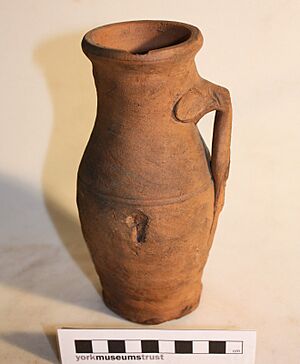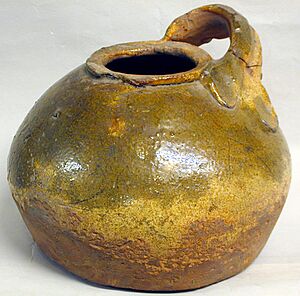Humber ware facts for kids
Humber ware is a special type of Medieval pottery made in England. It was produced in North Yorkshire from the late 1200s to the early 1500s. This pottery is named after the Humber River area where it was found. It was very popular for everyday use during its time.
Contents
Where Humber Ware Was Made
Humber ware was mostly made in specific places in England. Two of the most important pottery-making sites were at West Cowick and Holme-on-Spalding-Moor. There is also some proof that it was made near the city of York. Another kiln, which is a special oven for baking pottery, was found at Kelk. These areas were perfect for finding the right clay.
What Humber Ware Was Made Of
Humber ware was known for its strong, hard material. The potters used clay rich in iron, which often gave the pottery a reddish color. Sometimes, the inside of the pots looked darker. The clay usually had fine sand mixed in, making it strong. However, some pieces had a bit more grit. This special mix made the pottery very durable for daily use.
Shapes and Designs of Humber Ware
Humber ware came in many different shapes and sizes. Potters made jugs for pouring liquids. They also created cooking pots for preparing food. Later, they started making special pots for collecting liquids, like urinals, and large containers called bung-hole cisterns. Some Humber ware pieces even had a white layer inside. Scientists found this layer came from liquids that were stored in the pots.
The glaze, which is a shiny coating, was usually olive green or brownish green. Sometimes, the edges of the glaze looked a bit darker brown. The decoration on these pots was often simple. Potters would add horizontal lines around the top or neck of the pots. Sometimes, they used wavy patterns, small dots, or stamps for decoration. One of the most famous Humber ware items was a small drinking jug. These jugs became popular and replaced the wooden bowls people used before.

The Humber Ware Pottery Business
The Humber ware pottery business lasted for a long time. It started in the late 1200s and continued until the early 1500s. The busiest time for making Humber ware was around the 1400s. As Humber ware became more popular, another type of pottery called Brandsby-type ware was used less.
It's not exactly clear when the Humber ware industry ended. New types of pottery, like purple glazed ware, seemed to grow out of the Humber ware style. By the end of the 1400s, people started using fewer coarse pottery items, like cooking pots. This might be because metal pots became more common. Potters even started making their clay pots look like metal ones.
See also
- History of Yorkshire
- Medieval York
- Surrey whiteware
- Border ware
- List of English medieval pottery


